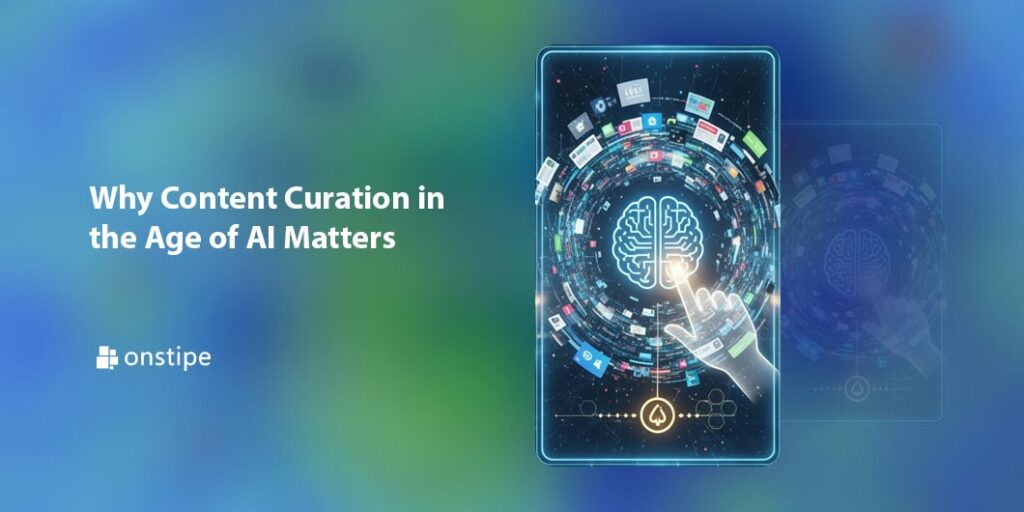The internet has never been louder.
There’s more content than anyone could ever consume, and it’s still continuously being flooded with countless new posts, videos, podcasts, blogs, and memes appearing every second.
In a world where attention is the new currency, standing out is less about shouting louder or creating new content; it’s about showing people what they’re looking for or curating it.
And now, with the dawn of AI, content curation will matter more than ever.
From Creating to Curating
In the past, digital marketing was all about creating content.
Brands raced to publish blogs, design infographics, and post endlessly on social media to get attention. The problem, however, is that there’s too much of it now. There are over 149 zettabytes of data on the internet—and 90% of it was created in the last two years.
On any given topic, no matter how niche, there are likely countless articles, social media posts, and videos about it online. The struggle for consumers isn’t about finding information—there’s too much of it now—it’s about getting to the content pieces that give them the most value.
That’s why content curation has become so valuable. Instead of posting your own content, it’s about finding, filtering, and sharing the best content on a given topic. All while still adding personal commentary or perspective.
Curation goes far beyond reposting. When properly done, it’s a form of storytelling on its own, helping people cut through the noise and the clutter and discover what’s truly worth their time.
AI: A Blessing and a Challenge
AI, of course, threw a wrench in all this, completely reshaping how we create, find, consume, and even curate content.
Not only has AI been powering our algorithms, deciding what we see on our feeds, and influencing us on what to watch, read, or buy next, but we’re now also beginning to swim in AI-generated everything.
AI-written blog articles and social media posts. Videos with AI voiceovers, videos, and images. AI summaries in search engines. Even supposedly “authentic” reviews or curated feeds.
Much of it looks and sounds the same. While convenient and useful in moderation, it’s also somewhat soulless when everything is automated.
After all, it can’t fully grasp the nuance of human experience. It can’t understand why certain stories resonate. It doesn’t have taste, empathy, or insight on a deep, guttural level. And that’s what we human beings will always crave, no matter how high-tech our society becomes: authenticity and sincerity.
And so in a world of information overload and AI-generated content, human curation is more vital than ever.
Curating Ethically
In an era where there’s too much information, there’s also a lot of misinformation. Fake reviews, clickbait-y headlines, and AI-generated deepfakes. Audiences are having a hard time distinguishing what’s real and what’s not. A recent survey indicated that only 26% percent of the public trusts information produced by AI. As a result of these findings, the curator’s role also evolves to include that of a trusted verifier.
As a curator, you have an ethical duty to make sure that what gets put out is also legitimate. Give credit, check facts by triangulating sources, and be respectful to the creators behind the content. Curating responsibly, after all, means being transparent and judicious about what you share.
Your followers’ privacy also matters. When gathering data about them, such as their demographic info or their IP address, it’s important to treat that information responsibly. Use it to understand your audience better, not to track or exploit them. For more information on IP addresses and user privacy, read more here.
When you curate responsibly by being honest and prudent about what you share and respecting the audience, you become someone the community can trust.
The Value of Human Judgment
AI can show you what’s trending or give a decent summary about a topic. But it’s people who can connect with you in a meaningful way.
Think of your favorite newsletters or community feeds. They feel unique because there’s a human curator behind it, combining data-driven insights with their own personal experience, blending strategy with sensitivity.
They know how to frame content so that it educates, inspires, or entertains—so that it tickles minds and touches hearts.
But imagine how a purely AI-curated newsletter might seem. You’ve likely seen AI-written articles before, right? It will likely be just as stale and predictable.
Of course, AI is still incredibly useful. From analytics to efficient research to data organization, AI can help human curators with the dirty work so they can focus on storytelling.
And that’s the future: human intuition, instinct, and sensitivity assisted by the raw computing power of AI.
The Future of Curation
Of course, AI continues to evolve. We’re still in the infancy of generative AI; who knows what it might look like in the future? The line between machine-generated and human-created content will blur even further.
But that doesn’t mean curation loses its purpose. In fact, for all the reasons we’ve already stated, it becomes more important.
The more you can stand out as a trustworthy human content creator or curator—all while reaping the efficiency benefits of AI—the more meaningful content you can create and the more people can be engaged as they trudge through a sea of repetitive and AI-generated content.
For example, imagine AI highlighting rising niche voices, while you choose which ones align with your brand’s image. Or think about how AI could help categorize user-generated photos from an event while you make the final picks on which images best represent it.
Why It All Matters
We don’t need more content (well, we probably need better content, not necessarily more). And AI is here to stay and is ever-evolving, with the ability to generate endless words and visuals.
What we need are guiding hands—curators who can help us find meaning in an endless sea of hollow words and synthetic images.
When done thoughtfully, with both heart and mind, curation isn’t just organization or reposting, it’s communication—it’s connection.







